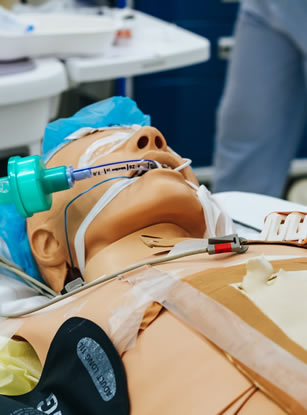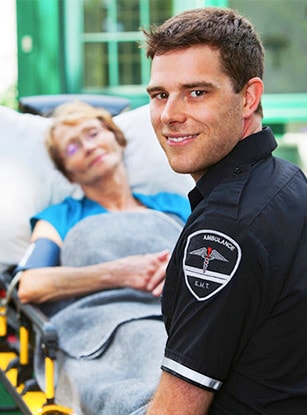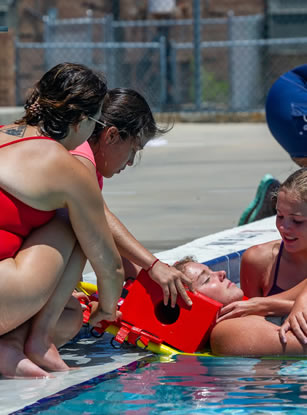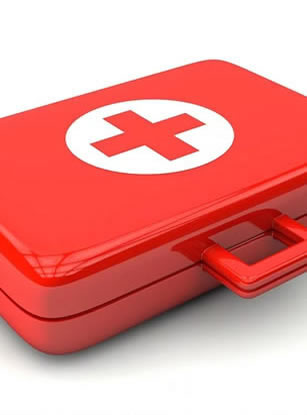Our Classes
Adult & Pediatric First Aid/CPR/AED
First Aid/CPR/AED Instructor Course
Basic Life Support for Healthcare
Blood-borne Pathogens
Baby Sitting Certification
Lifeguarding
Wilderness & Remote First Aid
Custom Courses
CPR and First Aid Training Class
Training My Employees
Train your employees with the knowledge and skills they need for effective leadership in the event of an emergency. From First Aid and CPR training, to Lifeguard and EMT certification, the American Red Cross has the emergency health and safety training and certification options available to suit your employee’s needs. Our trained solution specialists can custom tailor a program specifically around your organization. Learn more about all of our comprehensive courses, with online, blended simulation learning, and in-person options, as well as all of the latest learning tools and resources available in the United States today.
Understanding ANSI . . . Read More
ANSI/ISEA Z308.1-2015
American National Standard
Minimum Requirements for Workplace First Aid Kits and Supplies
Class and Types of First Aid Kits
Class A first aid kits are intended to provide a basic range of products to deal with most common types of injuries encountered in the workplace including: major wounds, minor wounds (cuts and abrasions), minor burns and eye injuries. First aid kits designated as Class A should contain the assortment of compliant supplies in the quantities specified in Table 1.
Class B kits are intended to provide broader range and quantity of supplies to deal with injuries encountered in more populated, complex and/or high risk workplace environments. First aid kits designated as Class B should contain the assortment of compliant supplies in the quantities specified in Table 1.
Type I first aid kits are intended for use in stationary, indoor settings where the potential for damage of kit supplies due to environmental factors and rough handling is minimal. Type I first aid kits shall have a means for mounting in a fixed position and are generally not intended to be portable.
Typical applications for Type I first aid kits may include, but are not limited to, the following: general indoor use, an office setting or a manufacturing facility. First aid cabinets would generally fall into the Type I classification.
Type II first aid kits are intended for portable use in indoor settings where the potential for damage of kit supplies due to environmental factors and rough handling is minimal. Typical applications for Type II first aid kits may include, but are not limited to, the following: general indoor use, an office setting or a manufacturing facility.
Type III first aid kits are intended for portable use in mobile, indoor and/or outdoor settings where the potential for damage of kit supplies due to environmental factors is not probable. Type III kits shall have a means to be mounted in a fixed position and shall have a water resistant seal. Typical applications for Type III first aid kits may include general indoor use and sheltered outdoor use.
Type IV first aid kits are intended for portable use in the mobile industries and/or outdoor settings where the potential for damage to kit supplies due to environmental factors and rough handling is significant. Type IV kits shall have a means to be mounted in a fixed position. Typical applications for Type IV first aid kits may include, but are not limited to, the following: the transportation industry, the utility industry, the construction industry, and the armed forces.

Understanding OSHA . . . Read More
General Industry
1910.151 Medical services and first aid
(b) In the absence of an infirmary, clinic, or hospital in near proximity to the workplace which is used for the treatment of all injured employees, a person or persons shall be adequately trained to render first aid. Adequate first aid supplies shall be readily available1
.
Construction Industry
1926.50 Medical services and first aid
(c) In the absence of an infirmary, clinic, hospital, or physician, that is reasonably accessible2
in terms of time and distance to the worksite, which is available for the treatment of injured employees, a person who has a valid certificate in first-aid training from the U.S. Bureau of Mines, the American Red Cross, or equivalent training that can be verified by documentary evidence, shall be available at the worksite to render first aid.
1 While the first standards do not prescribe a number of minutes, OSHA has long interpreted the term ‘near proximity’ to mean that emergency care must be available within no more than 3-4 minutes from the workplace. Medical literature establishes that, for serious injuries such as those involving stopped breathing, cardiac arrest, or uncontrolled bleeding, first aid treatment must be provided within the first few minutes to avoid permanent medical impairment or death.
Accordingly, in workplaces where serious accidents such as those involving falls, suffocation, electrocution, or amputation are possible, emergency medical services must be available within 3-4 minutes, if there is no employee on the site who is trained to render first aid.
2 The primary requirement addressed by this standard is that an employer must ensure prompt first aid treatment for injured employees, either by providing for the availability of a trained first aid provider at the worksite, or by ensuring that emergency treatment services are within reasonable proximity of the worksite. The basic purpose of these standards is to assure that adequate first aid is available in the critical minutes between the occurrence of an injury and the availability of
physician or hospital care for the injured employee.
One option these standards provide employers is to ensure that a member of the workforce has been trained in first aid. This option is, for most employers, a feasible and low-cost way to protect employees, as well putting the employer clearly in compliance with the standards. OSHA recommends, but does not require, that every workplace include one or more employees who are trained and certified in first aid, including CPR.
The other option for employers is to rely upon the reasonable proximity of an infirmary, clinic or hospital. OSHA has consistently taken the view that the reasonable availability of a trained emergency service provider, such as fire department paramedics or EMS responders, would be equivalent to the “infirmary, clinic, or hospital” specified by the literal wording of the standards. Emergency medical services can be provided either on-site or by evacuating the employee to an off-site facility in cases where that can be done safely.
However, the requirements that emergency medical services must be “reasonably accessible” or “in near proximity to the workplace” are stated only in general terms. An employer who contemplates relying on assistance from outside emergency responders as an alternative to providing a first-aid-trained employee must take a number of factors into account. The employer must take appropriate steps prior to any accident (such as making arrangements with the service provider) to
ascertain that emergency medical assistance will be promptly available when an injury occurs. While the standards do not prescribe a number of minutes, OSHA has long interpreted the term “near proximity” to mean that emergency care must be available within no more than 3-4 minutes from the workplace, an interpretation that has been upheld by the Occupational Safety and Health Review Commission and by federal courts.
Medical literature establishes that, for serious injuries such as those involving stopped breathing, cardiac arrest, or uncontrolled bleeding, first aid treatment must be provided within the first few minutes to avoid permanent medical impairment or death. Accordingly, in workplaces where serious accidents such as those involving falls, suffocation, electrocution, or amputation are possible, emergency medical services must be available within 3-4 minutes, if there is no employee on
the site who is trained to render first aid. OSHA exercises discretion in enforcing the first aid requirements in particular cases. OSHA recognizes that a somewhat longer response time of up to 15 minutes may be reasonable in workplaces, such as offices, where the possibility of such serious work-related injuries is more remote.
First Aid Kits to Consider
- Vehicle First Aid
- Bleeding Control
- Emergency Response Center
- Bloodborne Pathogen & Biohazard Spill Clean Up
- Burn Care
- CPR First Aid
- Consumer First Aid
Call or Fill in the Form for Your Free Safety Consultation
Call us:(808)202-2249









